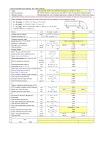
Course Overview
An important aspect of pump hydraulic system design is the suction or inlet conditions. Disregard for proper allowances can result in vortices, cavitation, and loss of prime. Pumps do not force liquids through inlet or suction piping, but rather create lowered pressures at the suction nozzle which in turn induces the fluid to enter. Any design that impedes or lessens the efficient transport of this liquid will, of course, result in less liquid being handled. Any design that encourages the introduction of entrained gas or liquid voids will likewise result in a less efficient pumping operation. In addition to poor performance, truly bad designs can in some cases actually result in physical damage to the pump or its parts.The study of pump suction system configuration can be broken down into two parts: (1) suction piping and (2) suction source. Critical consideration must be given to both in order to properly design an efficient system. Proper suction piping design and installation considerations consist of pipe and pipe fittings and their relationship, quantity, and relative location to the pump suction nozzle. Suction source design factors include the geometry of the source and the relative location of the suction entrance point(s) to suction liquid surface, source enclosure boundaries, and other suction entrance points. This course deals with both parts and is applicable generally to all types of pumps, since every pump’s successful operation and useful life can be so dependent on a properly designed and thought-out suction arrangement.
Course Introduction
There are many factors that affect the operation of a pump. Important factors are total head, speed, liquid properties, and physical arrangement/system connection. Included in the category of arrangement and connection are the suction conditions. Excessive suction lift, shallow inlet submergence, or insufficient Net Positive Suction Head available (NPSHA), all spell serious trouble from vibration, cavitation, lowered capacity, and reduced efficiency. While the Engineer may not have large control over some of the inherent process factors, with planning and foresight many times the pump suction conditions can be optimized in the design stage. This course offers ideas and summarizes generally accepted guidelines of practical consideration in pump suction arrangements.Summary
A hierarchy of the practical considerations for pump suction piping design and installation presented inthis course is:
- The optimum length of full-size straight pipe, devoid of any obstructions to flow, immediately upstream of the pump suction connection, should be 10D.
- The minimum length of full-size straight pipe, devoid of any obstructions to flow, immediately upstream of the pump suction connection, should be 5D.
- Taking points 1 and 2 above into consideration, the suction line should be as short as possible.
- The selected suction line pipe size should limit the mean fluid velocity to a maximum of 8 ft/sec understanding that more restrictive sizing criteria may govern, e.g., National Fire Protection Association (NFPA) Chapter 20 or consideration for conservation of solids suspension.
- The number of valves and fittings in the suction line should be minimized. Special examination and flow testing may be warranted for items such as strainers and suction diffusers.
- Suction piping should be designed and installed to minimize entrapped air. This consists of positive sloped lines, avoidance of horizontal plane concentric reducers, proper orientation of eccentric reducers, and rotation of valve stems to oppose the axis of the pump shaft plane.
- Directly connected elbows should be avoided and when absolutely necessary, should be of the long radius style oriented to minimize unbalanced flow to the pump impeller. If both a line size reductionand a piping direction change are required, consideration should be given to the reducing long radius elbow. Forty-five degree elbows should be favored over the 90E.
- Suction line pipe joint designs should be air-tight. This is particularly true in long suction lines and in situations in which the suction lift is large.
- The adherence to certain tried and true critical dimensions and relational geometries in suction intake structures are extremely important to suppress vortices, provide evenly distributed flow, and avoid aeration.
- Sump or reservoir design can not be considered as a simple intuitive process of creating a hole in the ground, but rather, must be given due diligence.








-page-001.jpg)



0 Comments